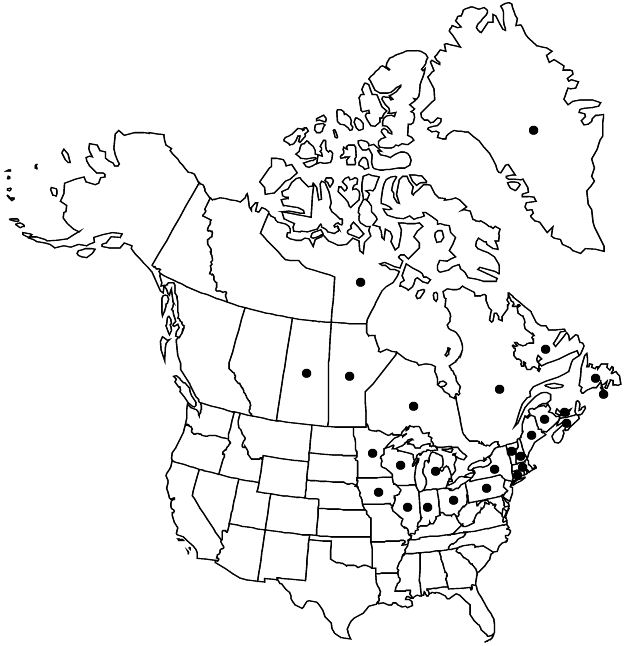Sorbus decora
Bull. Herb. Boissier, sér. 2, 6: 313. 1906.
Shrubs or trees, 30–150 dm. Stems 1–4+; bark gray to bronze; winter buds purplish at maturity, shiny, conic, 10–20 mm, glutinous, scales ciliate to moderately (densely) villous, hairs primarily rufous. Leaves pinnately compound; stipules deciduous, sometimes persistent, glabrous or with whitish and/or rufous hairs; blade paler abaxially, dull green to bluish green adaxially, leaflets (11–) 13–17, opposite, elliptic, oblong to oblong-ovate, 4–7 (–8) × 1.5–2.5 cm, l/w ratio 2.4–3.2 (–3.6), margins serrate, sometimes serrulate, at least in distal 1/2 and often almost to base, apex abruptly short-acuminate, cuspidate, acute, or obtuse, surfaces essentially glabrous or sparsely (moderately) villous at flowering, usually glabrescent thereafter, sometimes persistently villous along midveins abaxially; leaflet axils and petiole bases glabrous or with some rufous and/or whitish hairs adaxially. Panicles 75–400+-flowered, flat-topped or rounded, 6–15 cm diam.; peduncles sparsely to moderately (densely) villous. Pedicels sparsely to moderately (densely) villous. Flowers (7–) 8–12 mm diam.; hypanthium glabrous or sparsely villous proximally, hairs whitish or rufous, hypanthium plus sepals 2.5–3.5 mm; sepals 1–1.5 (–2) mm, margins entire, often with a few thick glands; petals white, orbiculate to obovate, (3–) 3.5–5 mm; stamens 15–20; carpels 1/2 adnate to hypanthium, apex conic, styles 3 or 4, 1.5–2.5 mm. Infructescences sparsely to moderately villous, rarely glabrous. Pomes bright red, globose to subglobose, (5–) 7–11 mm diam., shiny or dull, often glaucous when dried; sepals inconspicuous, incurved. Seeds brown, lanceoloid, 4.5–5 × 1.5–2 mm, slightly asymmetric, slightly flattened. 2n = 68.
Phenology: Flowering spring; fruiting fall.
Habitat: Moist or dry woods, montane woods, rocky slopes, lake and stream shores, thickets
Elevation: 0–1300 m
Distribution

Greenland, St. Pierre and Miquelon, Man., N.B., Nfld. and Labr., N.S., Nunavut, Ont., P.E.I., Que., Sask., Conn., Ill., Ind., Iowa, Maine, Mass., Mich., Minn., N.H., N.Y., Ohio, Pa., Vt., Wis.
Discussion
Sorbus decora reputedly flowers about one week later than S. americana. The two are sometimes confused when one is not familiar with the smaller flowers and fruits, and the distinctly longer and notably acuminate leaflets of S. americana. Leaflet length/width ratios greater than 3.2 are sometimes observed on narrower leaflets of S. decora, and a range of representative leaflets need to be sampled before determination. Another species frequently confused with S. decora is S. aucuparia, characterized by ovoid, usually densely whitish-villous and not glutinous winter buds as well as densely villous flowering pedicels and hypanthia, and often abaxially tomentose leaflets at flowering. The teeth on margins of leaves in S. decora are more finely pointed and sharper than those of S. aucuparia, and the apical tooth is often distinctly prolonged in S. decora; it is no more conspicuous than the lateral ones in S. aucuparia (E. G. Voss 1972–1996, vol. 2). The leaflets of S. aucuparia are reported to be minutely papillose abaxially (visible at 100× ); those of S. decora and other members of sect. Commixtae are not papillose (H. A. McAllister 2005). Sorbus decora is reported to be extirpated from Indiana.
Chromosome counts of 2n = 34 were reported by Á. Löve and D. Löve (1965, 1982b) for Sorbus decora. Doubt exists about the identity of the material that they sampled, as the only voucher specimen retraced (Á. & D. Löve 6559, COLO, WIN), although only vegetative and juvenile, is nonetheless referable to S. aucuparia. These doubtful chromosome counts also formed the basis for the recognition of S. groenlandica (Löve and Löve 1965b), reputedly of Greenland, coastal Labrador, and alpine and subalpine regions of northeastern North America, which apparently differed from S. decora with a chromosome count of 2n = 68 (T. W. Böcher and K. Larsen 1950; K. Holmen in C. A. Jørgensen et al. 1958). Reliable S. decora chromosome counts by H. A. McAllister (2005) of three wild collections (Dundas, Ontario; St. Anne de Beaupré, Quebec; Narsarsuaq Greenland) and two of cultivated material rendered this proposition untenable with consistent counts of 2n = 68. Further, critical examination of herbarium specimens from Greenland yielded no consistent morphologic character to separate S. decora from S. groenlandica, though leaflet and fruit size in the latter tended to be relatively smaller.
A naturally occurring putative intergeneric hybrid, ×Sorbaronia arsenii (Britton ex L. Arsène) G. N. Jones, synonym Pyrus ×arsenii (Britton ex L. Arsène) L. Arsène [= Aronia ×prunifolia (Marshall) Rehder × Sorbus decora], is known from New Brunswick, Nova Scotia, Prince Edward Island, St. Pierre and Miquelon, Quebec, and, possibly, Newfoundland. The hybrid is a 10–25 dm shrub with finely serrulate, partially pinnate leaves containing (0 or)1–3 pairs of reduced, distinct leaflets proximally and a much larger, 1–3-lobed terminal segment. The midvein on the adaxial surface of the terminal leaflet may be irregularly glandular or eglandular. A possible variant of this hybrid (parentage unconfirmed), much closer to Sorbus in appearance, is found in southwestern Newfoundland. It possesses finely serrulate, almost fully pinnate leaves, often with four or five pairs of distinct leaflets, the distal first or second leaflet pairs more or less pinnatifid or partially fused to the terminal leaflet. The hypanthium and abaxial surface of the sepals are villous, the anthers are pink or red, and the pomes are usually red, though some are reported to be blackish in age, often with some tomentum persisting on the abaxial surface of the persistent sepals.
Selected References
None.
Lower Taxa
"thin" is not a number."/2" is not declared as a valid unit of measurement for this property.
